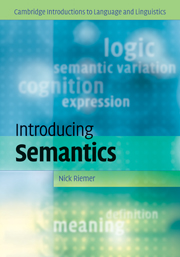Book contents
- Frontmatter
- Contents
- Note to the reader
- 1 Meaning in the empirical study of language
- 2 Meaning and definition
- 3 The scope of meaning I: external context
- 4 The scope of meaning II: interpersonal context
- 5 Analysing and distinguishing meanings
- 6 Logic as a representation of meaning
- 7 Meaning and cognition I: categorization and cognitive semantics
- 8 Meaning and cognition II: formalizing and simulating conceptual representations
- 9 Meaning and morphosyntax I: the semantics of grammatical categories
- 10 Meaning and morphosyntax II: verb meaning and argument structure
- 11 Semantic variation and change
- Glossary
- References
- Index
11 - Semantic variation and change
Published online by Cambridge University Press: 05 June 2012
- Frontmatter
- Contents
- Note to the reader
- 1 Meaning in the empirical study of language
- 2 Meaning and definition
- 3 The scope of meaning I: external context
- 4 The scope of meaning II: interpersonal context
- 5 Analysing and distinguishing meanings
- 6 Logic as a representation of meaning
- 7 Meaning and cognition I: categorization and cognitive semantics
- 8 Meaning and cognition II: formalizing and simulating conceptual representations
- 9 Meaning and morphosyntax I: the semantics of grammatical categories
- 10 Meaning and morphosyntax II: verb meaning and argument structure
- 11 Semantic variation and change
- Glossary
- References
- Index
Summary
CHAPTER PREVIEW
Variation is one of the most immediately obvious facts about meaning. Everyone is aware of how the meaning of identical expressions can differ from one person to another, sometimes significantly. There are two aspects of meaning variation: a synchronic and a dia-chronic (historical) one; we examine each in turn in this chapter. After a quick tour of some important preliminary questions (11.1), we begin diachronically by illustrating the traditional categories with which meaning change has been described, and we consider some of the shortcomings of this approach (11.2.1). We then move on to more recent studies of the pathways and mechanisms of semantic change (11.2.2) and a brief discussion of grammaticalization, the process by which full lexical words are converted into grammatical morphemes (11.2.3). The second half of the chapter discusses synchronic meaning variation. We start by examining the subtle types of semantic variation which exist within a single language community at any one time. Powerful new tools developed within corpus linguistics allow this kind of variation to be studied in a way that was not previously available: these are illustrated in 11.3. We then look at the field of semantic typology, which studies possible constraints on meaning variation and seeks out possible semantic universals in various semantic fields such as the body, colour, space and motion (11.4). Lastly, we consider the implications of these studies for the question of the influences between language and cognition, discussing the famous Sapir-Whorf or linguistic relativity hypothesis (11.5).
Sense, reference and metalanguage in semantic comparisons
Since meanings are unobservable, we cannot examine their historical variation or cross-linguistic universality directly in the way that we might, for instance, explore the history or distribution of a particular sound.
- Type
- Chapter
- Information
- Introducing Semantics , pp. 369 - 422Publisher: Cambridge University PressPrint publication year: 2010

